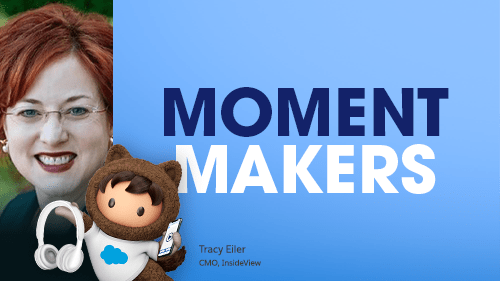This post from Tracy Eiler, CMO at InsideView, is part of our Moment Makers series, which takes a deep dive into how marketers use technology to build data-driven customer experiences that feel natural, relevant, and right on time.
When I joined InsideView five years ago, we were a one-product company that only sold to small and medium-sized businesses. But when we expanded our software-as-a-service platform and created an enterprise sales team, we faced a new challenge. Sales reps were courting much larger deals from much larger companies. And in almost every case, they went from nurturing a single lead in the business to engaging an entire panel of buyers.
Our new goal was to build connections with multiple people on an account and turn them into lifelong customers. We turned to an account-based marketing (ABM) strategy because it’s designed to help businesses navigate the more complicated deals we were now trying to win. It inspired us to have more thoughtful conversations about the accounts we wanted to focus on, provided a full view of everyone involved in the decision-making process, and helped us provide the right value to every customer. These benefits are more important than ever as businesses navigate obstacles in their industries, the economy, and more.
Most B2B marketers now have an ABM strategy, so your introduction may look similar to mine. But how can you tell if your strategy’s working? And if it’s time for a change, where do you start?
Thoughtful planning and a spirit of test-and-modify are part of the process for achieving ABM success. Research from the Boston Consulting Group found that 50% of the ABM programs failed in their first attempt — but 75% of scaled ABM programs succeeded after regrouping. I personally take issue with the term “fail.” InsideView has evolved its ABM strategy three times over the last four years and achieved success with each iteration. And we continue to improve.
Here are three insights that can help you grow your ABM strategy.
1. Approach ABM as a strategy, not a tool
Some people think of ABM as marketing technology or a set of tactics, but it’s more like a massive organisational shift. In fact, I prefer to call it “account-based engagement.” It’s not just marketing. However you think of it, one of the biggest things you’ll need to change is your process for account selection. Thoughtful planning will ensure you have the right targets.
The first round of ABM at InsideView relied on our sales team to choose accounts based on their territory knowledge and prospecting efforts. It was the sort of situation where a sales leader literally had a napkin with the names of their key accounts, and they were only talking to a few of the buyers who were involved. We knew this needed to change, so the next iteration of our strategy was data-driven. We worked with sales to better understand the companies we should be targeting and all the stakeholders we needed to build relationships with.
Next, we used marketing automation to comb through the details of 15 major deals we had closed over 18 months: 10 wins and five losses. For most of those deals, sales had only recorded three or so contacts from the buying committee. We knew there was a disconnect here, as Gartner research shows the average buyer group has six to 10 stakeholders. But our analysis revealed an even wider gap.
On some deals, more than 30 people from different levels of the account were engaging with our marketing campaigns. Marketing knew they were involved, but since we didn’t have a way to share that information across teams, sales didn’t. Imagine if they did! Our reps could have built more relationships with the right people and made the deal go faster. Today, our strategy includes maintaining a single, updated view of our accounts and all the stakeholders involved in our CRM. This provides a single source of truth that everyone in the company can work from.
2. Identify your ideal customer
Another important part of our strategy was building our ideal customer profile (ICP). These aren’t always the accounts you can sign the fastest — they’re the accounts most likely to stay with you the longest. You develop an ICP by figuring out what your highest-value accounts have in common. At InsideView, we pulled that list and sliced and diced their data: industries, company sizes, numbers of employees, regions, technology used, and more. We learned that industry had the most impact on a company’s likelihood of staying with us — five industries in particular. What did they have in common? They were all high-relationship buyers who tended to be very invested in their own customer relationships. This information helped us make more strategic decisions about the types of accounts we were best suited to work with.
That’s our ICP at InsideView. Yours may be different. The important thing is to dig through your customer data and evaluate whether they fit your ICP. Search through your company descriptions and find clues about how they do business with you. Use marketing automation to track account engagement and determine the most engaging content and marketing techniques for your buyers. Then, build your list of target accounts around your ICP and make sure marketing and sales are aligned in their pursuit of those accounts. Use conversational marketing to engage website visitors while they remain anonymous. You can get to engagement much faster.
Reimagining our strategy was hard work, but it produced great results. Last year, we grew business in the enterprise segment faster than ever, resulting in a doubling of the average deal size and improved account loyalty.
3. Engaging marketing, sales, and service for success
We’ve covered the benefits of aligning internal teams around a cohesive ABM strategy. But how do you get them working together? It starts with trust.
In many companies, once an account is in the pipeline, sales says to marketing, “I’ve got this.” In other words, stop communicating to these accounts while I close the deal. But earning this business takes a long time due to the number of people attached to an account. During those in-between months, there's a lot of things marketing can do to keep the conversation going — education, thought leadership, and so on. These teams are meant to complement each other, not compete with each other.
Historically, marketers have spent most of their time focused on bringing in new customers. That’s a mistake. Today’s marketers must think about how their company’s full product or service catalog can relate to the entire customer lifecycle. If your customers aren’t getting value from what they’ve already bought, they won’t buy more.
Along those lines, sales, marketing, and service can partner to make sure customers are getting value after the sale. Pretend to be a customer — experience everything from the welcome email to the training materials firsthand. A “secret-shopper” audit at InsideView identified a handful of gaps, which we fixed by making sure the entire post-sale customer experience was aligned with the marketing experience.
And finally, you have to meet regularly. At InsideView, we hold our Smarketing (Sales and Marketing) meeting once a month. We look at a six-week window, and ask: what just happened, where are we today, and what’s next? And we share as much information as possible to help each other build strong relationships with the most important contacts for each account.
But the marketing relationship isn’t just with sales. We talk to our service team and share data regularly to deliver a seamless customer experience across all teams.
Taking the next step with ABM
When I picture the future of ABM, I think of an infinity symbol focused around four key points: Find — Engage — Close — Grow. Find an account, engage them, win their business, grow their relationship with you — and then do it all over again. This version of the marketing funnel is never-ending instead of linear and puts a higher emphasis on long-term customer satisfaction as a way to grow revenue.
Work with your colleagues to examine every piece of it and identify what each group does well and where you can improve. Then build tactics to unlock revenue performance and take your account relationships to infinity.
Take your ABM strategy to the next level by:
Downloading the research report from the Boston Consulting Group Moving Beyond ABM to Account-Based Engagement, featuring InsideView
Watching the webinar How Marketers Are Driving Account Engagement and Growth with ABM
Marketing Cloud offers solutions for digital marketing, email marketing, social media marketing, customer journey mapping, marketing analytics, marketing automation, and B2B marketing to help you personalise customer communications across every digital touchpoint — from anywhere.



